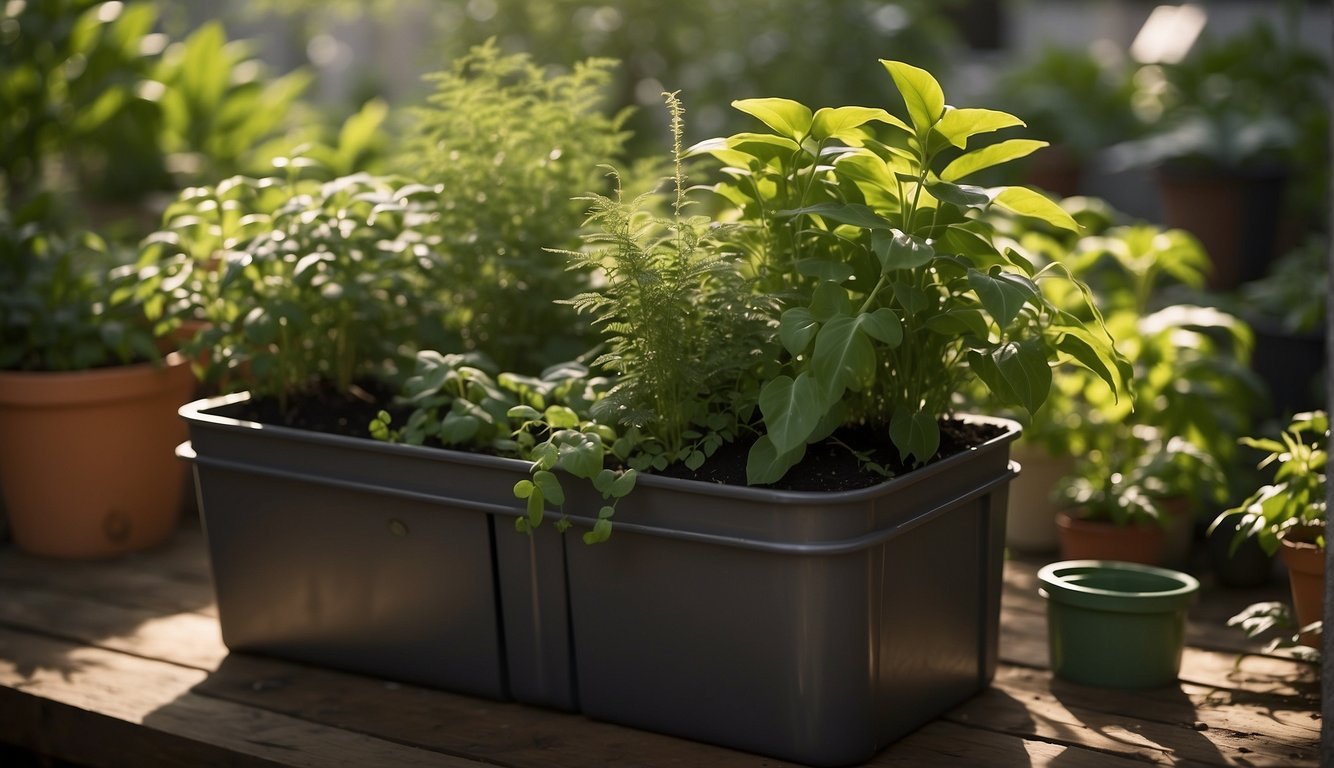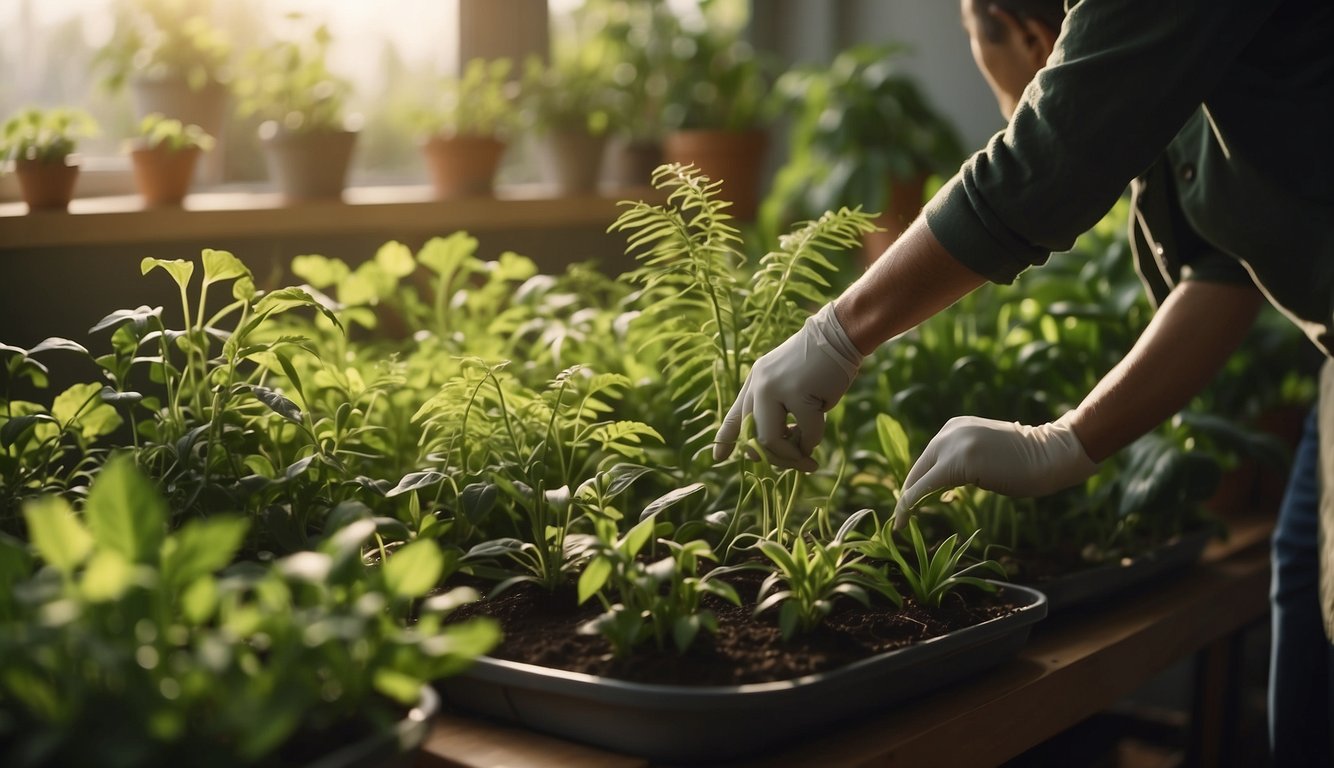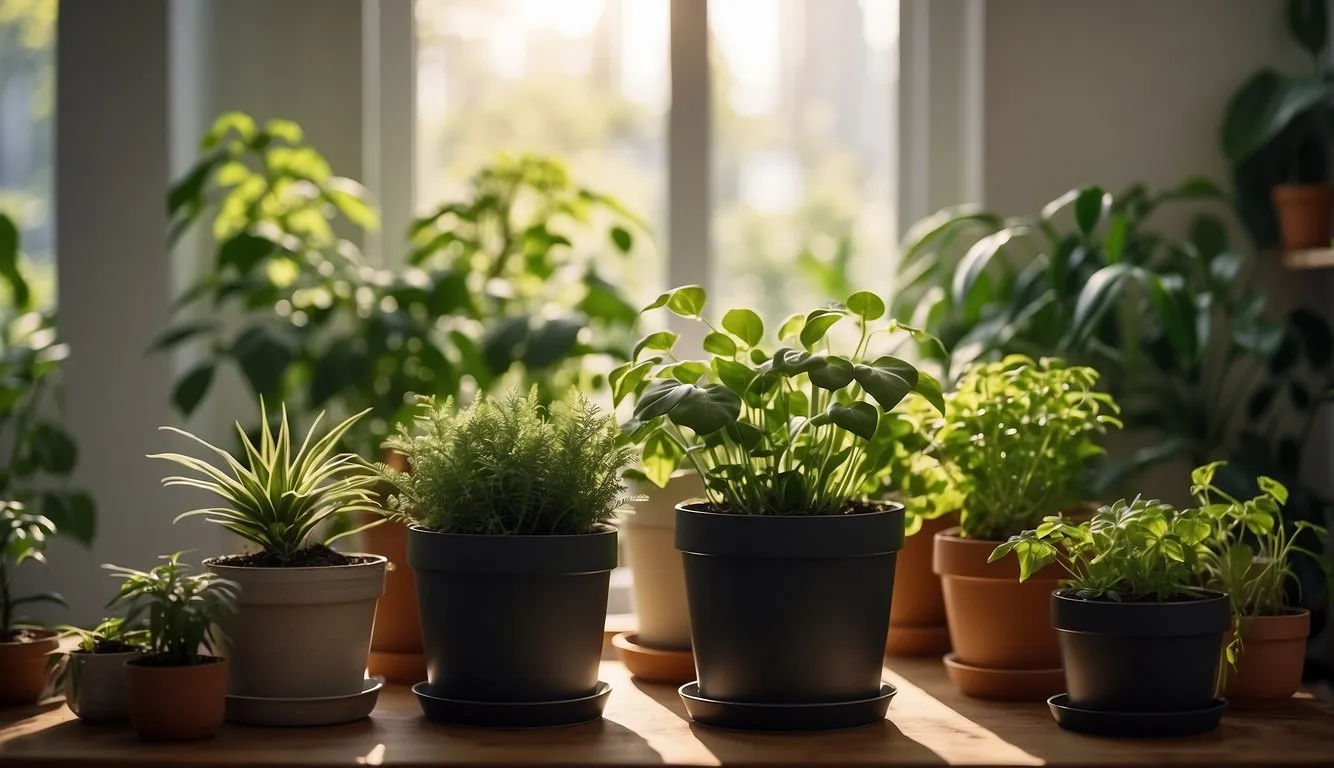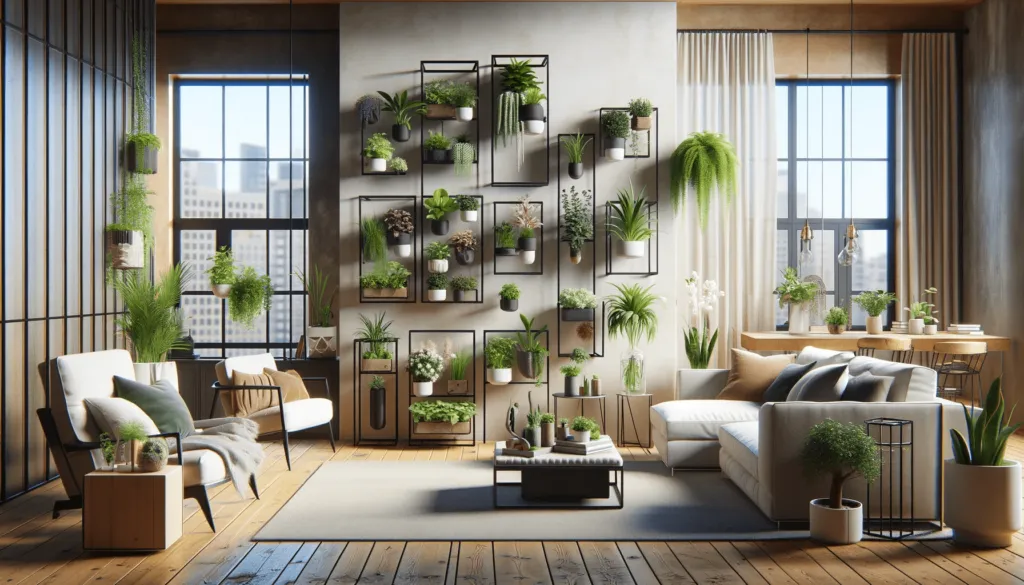Indoor gardening is a great way to bring the beauty and benefits of nature into our homes. Sustainable indoor gardening takes this a step further by incorporating eco-friendly practices that minimize environmental impact while maximizing the health and productivity of our plants. With the right plant selection and care, pest and disease management, and ecosystem creation, we can create a thriving indoor garden that not only enhances our well-being but also contributes to a greener lifestyle.

Choosing the right plants is the first step in sustainable indoor gardening. We should select plants that are well-suited to our indoor environment and that have a low environmental impact. Proper care is also essential to the success of our indoor garden. We should use organic and natural methods for fertilization and pest control, and conserve resources such as water and energy. By following these practices, we can create a sustainable indoor ecosystem that benefits both our plants and the planet.
Table of Contents
Key Takeaways
- Sustainable indoor gardening combines the joys of gardening with eco-friendly practices that minimize environmental impact.
- Choosing the right plants and using natural methods for care and pest control are essential to creating a thriving indoor garden.
- By creating a sustainable indoor ecosystem, we can enjoy the benefits of nature while contributing to a greener lifestyle.
Plant Selection and Care
When it comes to indoor gardening, selecting the right plants and providing them with proper care is crucial for their growth and survival. In this section, we will cover some important aspects of plant selection and care, including understanding light and temperature, watering and humidity control, and soil and fertilization.
Understanding Light and Temperature
Light and temperature are two of the most important factors to consider when choosing plants for your indoor garden. Different plants have different light and temperature requirements, so it’s important to choose plants that are well-suited to your specific indoor environment.
Some plants, such as snake plants, succulents, and cacti, can tolerate low light conditions and are ideal for rooms with less natural light. Other plants, such as spider plants, pothos, and philodendron, require more natural light to thrive.
In addition to light, temperature is also an important consideration. Most indoor plants prefer temperatures between 60-75°F (15-24°C). However, some plants, such as the ZZ plant and aloe vera, can tolerate a wider range of temperatures.
Watering and Humidity Control
Proper watering and humidity control are essential for the health of your indoor plants. Overwatering can lead to root rot, while underwatering can cause wilting and other issues.
To ensure proper watering, it’s important to understand the water requirements of your plants. Some plants require more water than others, and some prefer to dry out between waterings. Water-saving techniques, such as using a self-watering planter or collecting rainwater, can also help conserve water.
Humidity is also important, as many indoor plants prefer a humid environment. To increase humidity, you can use a humidifier or place a tray of water near your plants. Misting your plants with water can also help increase humidity.
Soil and Fertilization
Finally, soil and fertilization are important aspects of indoor plant care. Choosing the right soil and fertilizers can help ensure that your plants get the nutrients they need to grow and thrive.
Organic fertilizers, such as compost and worm castings, are a great choice for indoor gardening, as they are environmentally friendly and provide a rich source of nutrients for your plants. It’s also important to choose the right soil for your plants, as different plants have different soil requirements.
In summary, selecting the right plants and providing them with proper care is essential for successful indoor gardening. By understanding light and temperature requirements, proper watering and humidity control, and soil and fertilization, we can create a thriving indoor garden that is both sustainable and beautiful.
Pest and Disease Management

As with any garden, indoor gardens are susceptible to pests and diseases. However, with sustainable indoor gardening practices, we can manage these problems effectively without resorting to harmful chemicals and pesticides.
Natural Pest Control Strategies
One effective natural pest control method is the use of beneficial insects such as ladybugs. These insects are natural predators of common indoor pests such as aphids, mealybugs, and spider mites. Another natural pest control method is the use of neem oil, which is derived from the neem tree and is effective against a wide range of pests.
Insecticidal soap is another natural pest control method that can be used to manage common indoor pests. This soap is made from natural ingredients and is effective against pests such as aphids, spider mites, and mealybugs.
Preventing Common Problems
Preventing common problems such as root rot and yellowing leaves is essential to maintaining a healthy indoor garden. One way to prevent root rot is to ensure that your plants are not overwatered and that they are planted in well-draining soil. Yellowing leaves can be a sign of a nutrient deficiency, so it is important to ensure that your plants are receiving the proper nutrients.
Regularly inspecting your plants for signs of pests and diseases is also important in preventing common problems. If you notice any signs of pests or diseases, it is important to take action immediately to prevent the problem from spreading.
By implementing natural pest control methods and taking steps to prevent common problems, we can maintain a healthy and sustainable indoor garden without resorting to harmful chemicals and pesticides.
Creating a Sustainable Indoor Ecosystem
When it comes to sustainable indoor gardening, creating a thriving ecosystem is key. By implementing eco-friendly practices and conservation techniques, we can reduce our environmental impact and promote a healthier planet. In this section, we’ll explore some of the ways we can create a sustainable indoor ecosystem.
Eco-Friendly Practices
One of the most important aspects of sustainable indoor gardening is using eco-friendly practices. This includes using organic soil, sustainable plant varieties, and energy-efficient lighting. By choosing organic soil, we can avoid harmful pesticides and chemicals that can harm the environment. Sustainable plant varieties are also important, as they require less water and are more resilient to pests and diseases. Finally, using energy-efficient lighting can help reduce our energy consumption and lower our carbon footprint.
Another important eco-friendly practice is recycling and composting. By recycling items such as plastic pots and trays, we can reduce waste and conserve resources. Composting kitchen scraps is also a great way to create nutrient-rich soil for our indoor garden. Repurposing items such as old furniture or containers can also help reduce waste and create a unique and sustainable garden.
Conservation Techniques
Conservation techniques are another important aspect of creating a sustainable indoor ecosystem. Water-saving techniques such as drip irrigation or using a moisture meter can help reduce water consumption and promote healthy plant growth. Energy-saving techniques such as using natural light or LED bulbs can also help reduce our energy consumption.
Finally, we can promote sustainability by using a sustainable garden design. This includes using native plants, creating a rain garden, and using permeable surfaces. By using a sustainable garden design, we can reduce our environmental impact and create a beautiful and healthy indoor garden.
In conclusion, creating a sustainable indoor ecosystem requires a combination of eco-friendly practices and conservation techniques. By using organic soil, sustainable plant varieties, and energy-efficient lighting, we can reduce our environmental impact and promote a healthier planet. Recycling, composting, and repurposing items can also help reduce waste and conserve resources. Water-saving and energy-saving techniques can also help reduce our consumption and promote sustainability. Finally, using a sustainable garden design can help reduce our environmental impact and create a beautiful and healthy indoor garden.
Harvesting and Utilization

Once your indoor garden has reached maturity, it is time to harvest your fresh produce. Harvesting at the right time is crucial to ensure that your plants are at their peak flavor and nutritional value. We recommend harvesting in the morning when the plants are fully hydrated and the temperatures are cooler.
When harvesting, use clean, sharp tools to avoid damaging the plants. For herbs, you can simply snip off the leaves as needed. For edible plants, gently pull the produce from the stem or cut it off using a knife or scissors. Be sure to leave some produce on the plant to allow for continued growth and future harvests.
Once harvested, it’s time to put your fresh produce to use. Whether you’re cooking up a storm or simply enjoying a fresh salad, your homegrown produce will add a burst of flavor and nutrition to any dish. We recommend experimenting with different recipes and flavor combinations to fully enjoy the fruits of your labor.
In addition to using your produce fresh, you can also preserve it for later use. Drying herbs is a great way to extend their shelf life and ensure that you always have fresh herbs on hand. You can also freeze or can your produce to enjoy it throughout the year.
By harvesting and utilizing your indoor garden’s fresh, organic produce, you are not only enjoying the benefits of homegrown food, but also reducing your carbon footprint and supporting sustainable practices.
Conclusion

In conclusion, we can see that sustainable indoor garden practices offer numerous benefits to both our lifestyle and the environment. By reducing waste and reusing materials such as yard waste, we can minimize our impact on the planet and contribute to a greener future.
Indoor gardening also offers a range of benefits to our health and well-being, including improved air quality, reduced stress levels, and a stronger connection to nature. By choosing eco-friendly practices and selecting the right plants, we can create a thriving indoor garden that enhances our living space and supports our overall health.
In addition to the environmental and health benefits, sustainable indoor gardening also provides an opportunity to grow fresh, organic produce right in our own homes. This not only reduces our carbon footprint by cutting down on transportation and packaging, but also ensures that we have access to healthy, nutrient-rich food year-round.
Overall, adopting sustainable indoor garden practices is a simple yet effective way to make a positive impact on the planet while enhancing our own lives. By taking small steps towards a greener lifestyle, we can create a more sustainable future for ourselves and future generations.
Frequently Asked Questions
What are the best practices for water conservation in an indoor garden?
Water conservation is an important aspect of sustainable indoor gardening. To conserve water, we recommend utilizing rainwater harvesting, using organic mulches, and choosing drought-resistant plants. You can also install a drip irrigation system to deliver water directly to the roots of your plants, which reduces water waste and ensures that your plants receive the right amount of water.
How can I ensure proper nutrient management for my indoor plants?
Proper nutrient management is essential for healthy indoor plants. To ensure that your plants receive the right nutrients, we recommend using organic fertilizers and compost. You can also create a compost bin with kitchen scraps and yard waste, which will provide a rich source of nutrients for your plants. Additionally, you can test your soil periodically to ensure that it has the right pH balance and nutrient levels.
What are the most energy-efficient lighting options for indoor gardening?
Lighting is an important aspect of indoor gardening, but it can also be a major source of energy consumption. To reduce energy consumption, we recommend using LED grow lights, which are more energy-efficient than traditional lighting options. LED grow lights also produce less heat, which reduces the need for additional cooling systems.
How can I reduce waste and reuse materials in my indoor gardening setup?
Reducing waste and reusing materials is an important aspect of sustainable indoor gardening. To reduce waste, we recommend using compostable or biodegradable pots and avoiding single-use plastics. You can also repurpose materials such as old containers, jars, and bottles to create planters and other gardening tools. Additionally, you can compost plant waste and use it to fertilize your plants.
What are the benefits of using non-toxic, organic pest control methods indoors?
Using non-toxic, organic pest control methods is important for maintaining a healthy indoor environment. Chemical pesticides can be harmful to both humans and pets, and they can also damage the soil and plants. We recommend using natural pest control methods such as companion planting, neem oil, and insecticidal soap. These methods are effective at controlling pests while also promoting a healthy indoor environment.
What types of plants are most suitable for creating a low-maintenance indoor garden?
Low-maintenance plants are ideal for indoor gardening, especially if you have a busy schedule or are new to gardening. Some low-maintenance plants include succulents, spider plants, and pothos. These plants require minimal watering and can thrive in a variety of lighting conditions. Additionally, they are easy to propagate, which means that you can grow more plants from a single parent plant.


